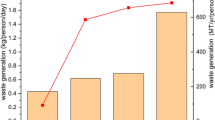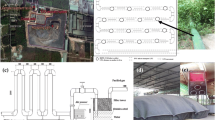Abstract
Nitrous oxide and carbon dioxide were continuously measured and variability of emission factors (EFs) was evaluated in five municipal waste incinerators (MWIs) and four industrial waste incinerators (IWIs) from 24 to 86 days between 2008 and 2011. N2O EFs were calculated by Monte Carlo simulation and mean N2O EFs were 7.1, 107, 127, 219 g N2O/ton waste combusted in MWIs with selective catalytic reduction (SCR) for NOx control, MWIs with selective non-catalytic reduction (SNCR), IWIs with SNCR, and a MWI using fluidized bed with SNCR, respectively. Climate-relevant CO2 EFs ranged from 0.45 to 0.72 ton CO2/ton waste combusted in MWIs. Maximum values of upper limit for 95% confidence intervals (CIs) of N2O EFs estimated in each MWIs with SCR, MWIs with SNCR, IWIs with SNCR were 185, 94, 101% of mean N2O EFs, respectively. Meanwhile, maximum values of upper limit for 95% CIs of CO2 EFs were much lower as between 18 and 36% in those facilities. 84% CIs of mean N2O EFs in MWIs with SNCR and IWIs with SNCR were overlapped indicating those values are not significantly different.


Similar content being viewed by others
References
Yang N, Zhang H, Chen M, Shao L-M, He P-J (2012) Greenhouse gas emissions from MSW incineration in China: impacts of waste characteristics and energy recovery. Waste Manag 32:2552–2560
IPCC (2006) 2006 IPCC Guidelines for National Greenhouse Gas Inventories. In: Eggleston HS, Buendia L, Miwa K, Ngara T, Tanabe K (eds) Prepared by the National Greenhouse Gas Inventories Programme. IGES, Japan
Quina MJ, Bordado JCM, Quinta-Ferreira RM (2011) Air pollution control in municipal solid waste incinerators. http://cdn.intechopen.com/pdfs/18646.pdf. Accessed 30 Apr 2017
UNFCCC (2016) Greenhouse gas inventory data—detailed data by party. http://unfccc.int/di/DetailedByParty.do. Accessed 30 Apr 2017
BREF (2006) Integrated Pollution Prevention and Control—Reference Document on the Best Available Techniques for Waste Incineration, European Commission
Korhonen S, Fabritius M, Hoffren H (2001) Methane and nitrous oxide emissions in the Finnish energy production. Fortum Power and Heat Oy. (TECH-4615), Vantaa
Kilpinen P (2002) Formation and decomposition of nitrogen oxides. In: Raiko R, Saastamoinen J, Hupa M, Kurki-Suonio I (eds) Poltto ja palaminen. International Flame Research Foundation - Suomen kansallinen osasto. Gummerus Oy, Jyväskylä, Finland. [In Finnish]
Tsupari E, Monni S, Pipatti R (2005) Non-CO2 greenhouse gas emissions from boiliers and industrial processes-Evaluation and update of emission factors for the Finnish National Greenhouse Gas Inventory. VTT Research Notes 2321. Espoo, Finland
Monni S, Syri S, Savolainen I (2004) Uncertainties in the Finnish greenhouse gas emission inventory. Environ Sci Policy 7(2):87–98. doi:10.1016/j.envsci.2004.01.002
Frey HC, Junyu Z (2002) Quantification of variability and uncertainty in air pollutant emission inventories: method and case study for utility NOx emissions. J Air Waste Manag Assoc 52(9):1083–1095
US EPA (2016) Uncertainty and Variability. https://www.epa.gov/expobox/uncertainty-and-variability. Accessed 30 Apr 2017
Tong L, Chang C-W, Jin S-E, Saminathan R (2012) Quantifying uncertainty of emission estimated in national greenhouse gas inventories using bootstrap confidence intervals. Atmos Environ 56:80–87
Romano D, Bernetti A, Lauretis RD (2004) Different methodologies to quantify uncertainties of air emissions. Environ Int 30:1099–1107
Choi E, Shin E, Seo Y-S, Kim JY, Yi S-M (2017) The application and development of country-specific parameters for accurate estimations of methane emissions from solid-waste disposal sites. J Mater Cycles Waste Manag 19(3):1117–1126
UNFCCC (2016) National Reports—GHG Inventories (Annex I)—National Inventory Submissions. http://unfccc.int/national_reports/annex_i_ghg_inventories/national_inventories_submissions/items/9492.php. Accessed 18 May 2016
GIR (2015) National Greenhouse Gas Inventory Report of Korea. No. 11-1480000-001357-10
Ministry of Environment, Republic of Korea (2008) The status of generation and treatment of national waste
Ministry of Environment, Republic of Korea (2009) The status of generation and treatment of national waste
Ministry of Environment, Republic of Korea (2013) Environmental Review 2013 ECOREA
Ministry of Environment, Republic of Korea (2014) 2014 White paper of Environment
National Institute of Environmental Research (2013) Notification on the approval and accuracy inspection of environment measuring instrument
US EPA Specific provisions for monitoring CO2 emissions; vol 40, CFR, part 75.13
Energy Act, Republic of Korea
Management council of nationwide MWIs with energy recovery (2008–2013). Annual Statistics on MWIs with energy recovery
Ministry of Environment, Republic of Korea (2013) The 4th survey on national waste (2011–2012)
US EPA (1997) Guiding Principles for Monte Carlo Analysis, EPA/630/R-97/001
Couto PRG, Damasceno JCD, Oliveira SP (2013) Theory and applications of monte carlo simulation, chapter 2. Monte Carlo Simulations Applied to Uncertainty in Measurement. ISBN 978-953-51-1012-5
Ogle SM, Breidt FJ, Eve MD, Paustian K (2003) Uncertainty in estimating land use and management impacts on soil organic carbon storage for US agricultural lands between 1982 and 1997. Glob Change Biol 9:1521–1542
Harris E, Zeyer K, Kegel R, Müller B, Emmenegger L, Mohn J (2015) Nitrous oxide and methane emissions and nitrous oxide isotopic composition from waste incineration in Switzerland. Waste Manag 35:135–140
IEA GHG R&D (2000) Abatement of other greenhouse gases. Nitrous oxide. Report number PH3/29
Swedish Environment Emissions Data (2014) Revision of N2O emission factors for combustion of gaseous and solid fuels. Contact No.: 2250-14-004
Buekens A (2013) Incineration technologies. Springer, New York
Amand L-E, Leckner B (1992) Influence of air supply on the emissions of NO and N2O from a circulating a fluidized bed boiler. In: Twenty-Fourth symposium on combustion, the combustion institute, pp 1407–1414
IPCC (1997) Revised 1996 IPCC Guidelines for National Greenhouse Gas Inventories
Ministry of the Environment, Japan Greenhouse Gas Inventory Office of Japan (GIO), CGER, NIES (2016) National Greenhouse Gas Inventory Report of JAPAN
National Institute for Public Health and the Environment (2016) Greenhouse gas emissions in the Netherlands 1990–2014 National Inventory Report 2016 RIVM Report 2016-0047
Environment Agency Austria (2016) Austria’s National Inventory Report 2016
Reed RJ (1978) North American combustion handbook, Second edn. North American Mfg Co, Cleverland, pp 44105
Statistics Finland (2016) Greenhouse Gas emissions in Finland 1990–2014, National Inventory Report under the UNFCCC and the Kyoto Protocol
Federal Environment Agency (2016) National Inventory Report, Germany 2016
Norwegian Environmental Agency (2016) Greenhouse Gas Emissions 1990–2014, National Inventory Report
Johnke, B (2002) Emissions from waste incineration, Background paper, IPCC expert meetings on Good Practice Guidance and Uncertainty Management in National Greenhouse Gas Inventories
Chen T-C, Lin C-F (2010) CO2 emission from municipal solid waste incinerator: IPCC formula estimation and flue gas measurement. J Environ Eng Manag 20(1):9–17
Nielsen O-K, Plejdrup MS, Winther M, Nielsen M, Gyldenkærne S, Mikkelsen MH, Albrektsen R, Thomsen M, Hjelgaard K, Fauser P, Bruun HG, Johannsen VK, Nord-Larsen T, Vesterdal L, Møller IS, Schou E, Suadicani K, Rasmussen E, Petersen SB, Baunbæk L, Hansen MG (2016) Denmark’s National Inventory Report 2016. Emission Inventories 1990–2014. Aarhus University, Scientific Report from DCE—Danish Centre for Environment and Energy
Larsen Anna W, Astrup Thomas (2011) CO2 emission factors for waste incineration: influence from source separation of recyclable materials. Waste Manag 31:1597–1605
IPCC EFDB (2016). http://www.ipcc-nggip.iges.or.jp/EFDB/find_ef_s1.php. Accessed 30 Apr 2017
Zhao Y, Frey HC (2004) Development of probabilistic emission inventories of air toxics for Jacksonville, Florida. J Air Waste Manag Assoc 54(11):1405–1421
Winiwarter W, Rypdal K (2001) Assessing the uncertainty associated with a national greenhouse gas emission inventory: a case study for Austria. Atmos Environ 35:5425–5440
Lee S, Choi Y, Woo J, Kang W, Jung J (2014) Estimating and comparing greenhouse gas emissions with their uncertainties using different methods: a case study for an energy supply utility. J Air Waste Manag Assoc 64(10):1164–1173
Payton ME, Greenstone MH, Schenker N (2003) Overlapping confidence intervals or standard error intervals: what do they mean in terms of statistical significance? J Insect Sci 3:34
Julious SA (2004) Using confidence intervals around individual means to asses statistical significance between two means. Pharm Stat 3:217–222
Acknowledgements
The publication was made possible, in part, by a Korea Environment Corporation. This study was supported by the Korean Ministry of the Environment as part of the “Project of Environmental Technology Development for Responding to Climate Change.” Funding was provided by Korea Environmental Industry and Technology Institute.
Author information
Authors and Affiliations
Corresponding author
Ethics declarations
Conflict of interest
The authors declare no competing financial interest.
Rights and permissions
About this article
Cite this article
Choi, E., Eum, H., Seo, YS. et al. Variability of nitrous oxide and carbon dioxide emissions continuously measured in solid waste incinerators. J Mater Cycles Waste Manag 20, 832–843 (2018). https://doi.org/10.1007/s10163-017-0644-y
Received:
Accepted:
Published:
Issue Date:
DOI: https://doi.org/10.1007/s10163-017-0644-y




